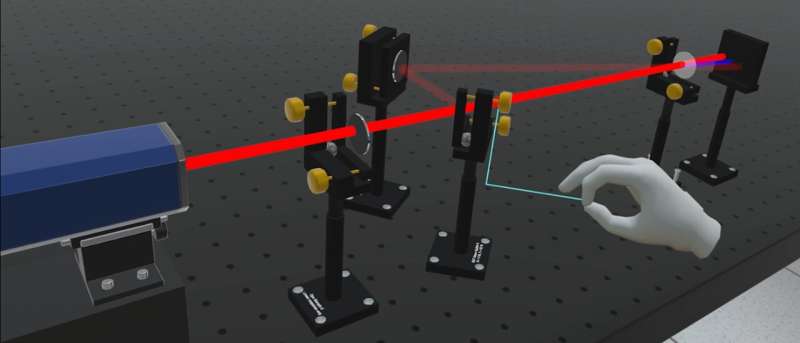
In everyday life, we know lasers from numerous applications such as the laser printer or the supermarket scanner. Industrially, lasers are used in material processing for cutting, drilling and labeling, and in medicine for diagnostic and therapeutic procedures. Laser spectroscopy methods are also indispensable in scientific research.
Theoretical education in optics is established at schools, universities and industrial sites. However, it is challenging to teach and learn the setup and proper handling of optical experiments. Due to high costs, equipment and teaching staff are usually limited. In addition, laser radiation is dangerous, so strict eye safety protocols must be followed.
New teaching approach in virtual reality
Now, scientists at the Julius-Maximilians-University (JMU) of Würzburg have developed the novel virtual-reality (VR) laser laboratory “femtoPro.” In femtoPro, users wear VR goggles and manipulate optical elements on a VR laser table. In this way, the coarse and fine positioning of mirrors, lenses, iris apertures or other devices can be changed intuitively and with the same attention to detail as in the real laboratory. The properties and effects of these elements on the laser beam are calculated and displayed in real time according to physical laws.
“Flight simulators have become indispensable for the realistic practical training of pilots. We have now applied this concept to short-pulse lasers for the first time worldwide,” explains Professor Tobias Brixner, one of the femtoPro developers and head of the Chair of Physical Chemistry I at the JMU Würzburg, whose research focuses on ultrashort laser pulses.
Low costs despite high complexity
The difficulty with the VR approach is that, contrary to popular belief, laser beams are not just “line-shaped,” but have a “Gaussian” cross-section whose diameter can grow larger and smaller as they propagate. Moreover, the interaction with matter is highly complex and includes widely known phenomena such as refraction of light on a glass, as well as nonlinear optics leading to frequency conversion (i.e., color change). As a result, accurate simulation is usually very time-consuming.
“In order to realize an interactive learning lab for such optical systems in VR, we had to accelerate the necessary calculations so that they run in real time on a commercially available consumer VR platform,” explains cooperation partner Professor Sebastian von Mammen, head of the Games Engineering group at the Computer Science Chair for Human-Computer Interaction at JMU. As a result, the acquisition costs of the virtual lab amount to only a few hundred euros, while a real short-pulse laser lab would require an investment of hundreds of thousands of euros.
Product launch at the “Highlights der Physik” event
After two years of development work, the first version of femtoPro will now be presented to the public for the first time at the “Highlights der Physik” event in Würzburg. As part of a large hands-on exhibition at the marketplace from September 28 to October 2, 2021, interested parties can put on VR goggles themselves at booth B2 (“May the Force be with you! – Lightsaber and Laser Pulses”) and experiment with lasers in the virtual laboratory.
Launch event: www.highlights-physik.de/
Citation:
World premiere for virtual laser lab “femtoPro” (2021, September 24)
retrieved 24 September 2021
from https://phys.org/news/2021-09-world-premiere-virtual-laser-lab.html
This document is subject to copyright. Apart from any fair dealing for the purpose of private study or research, no
part may be reproduced without the written permission. The content is provided for information purposes only.


